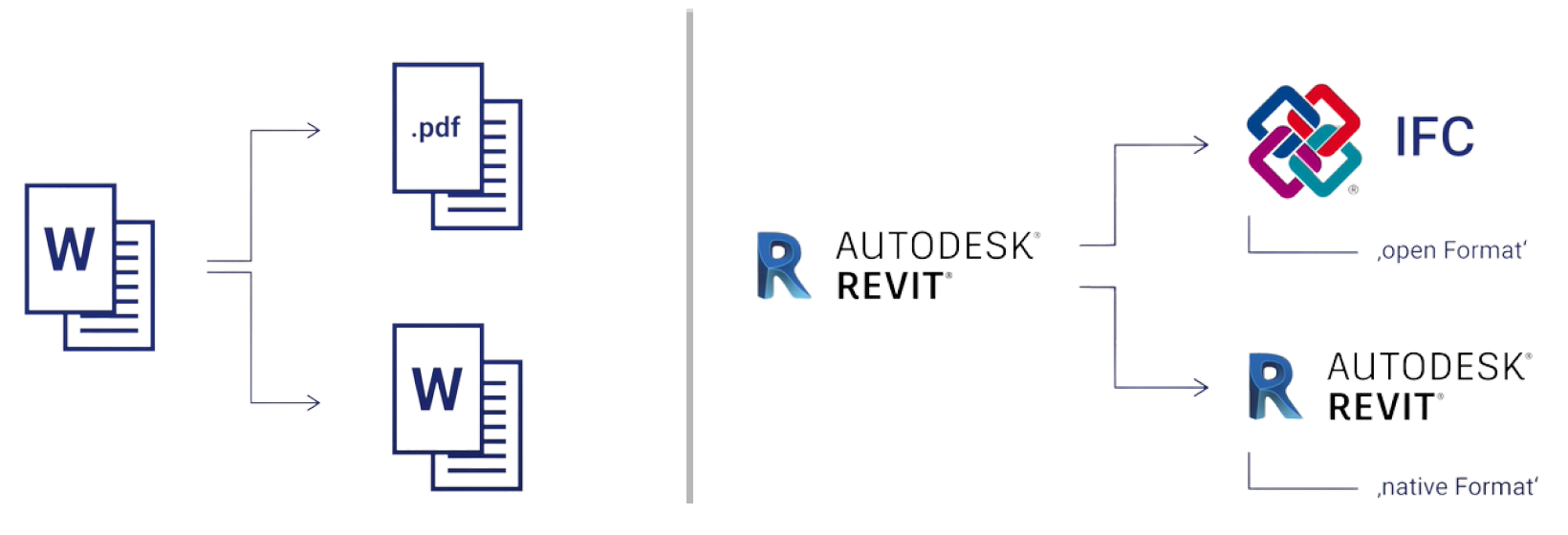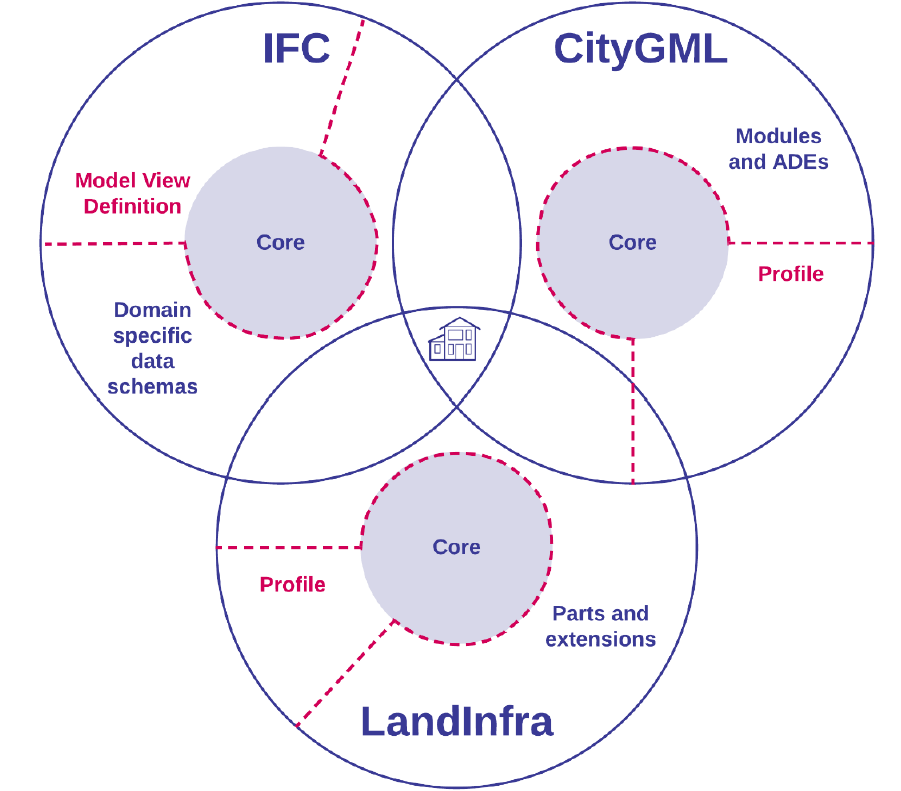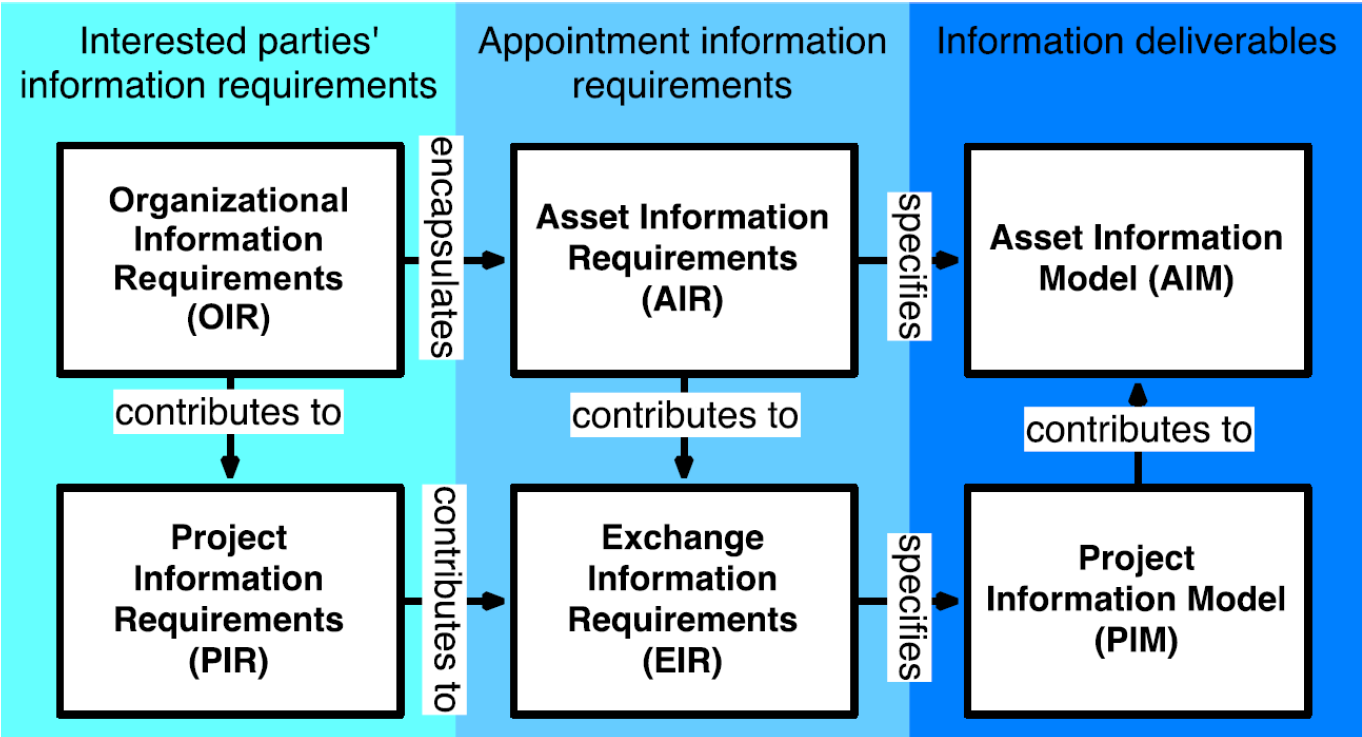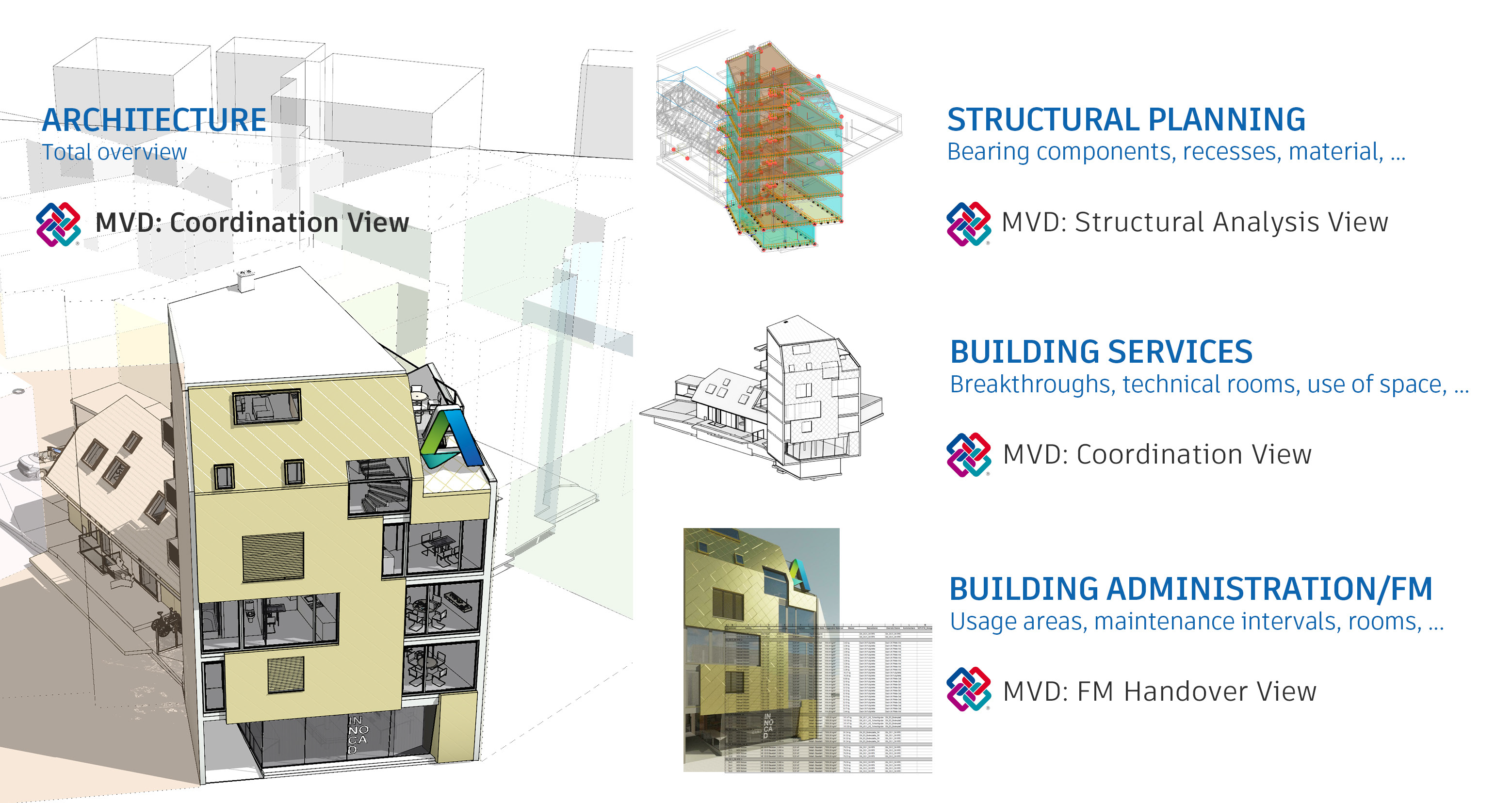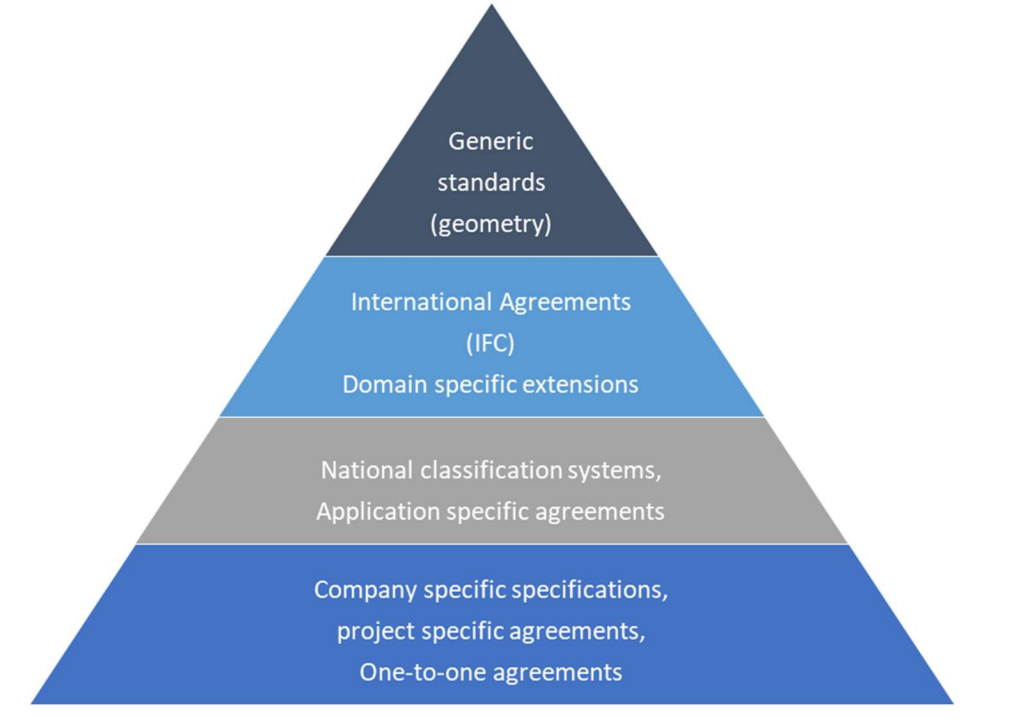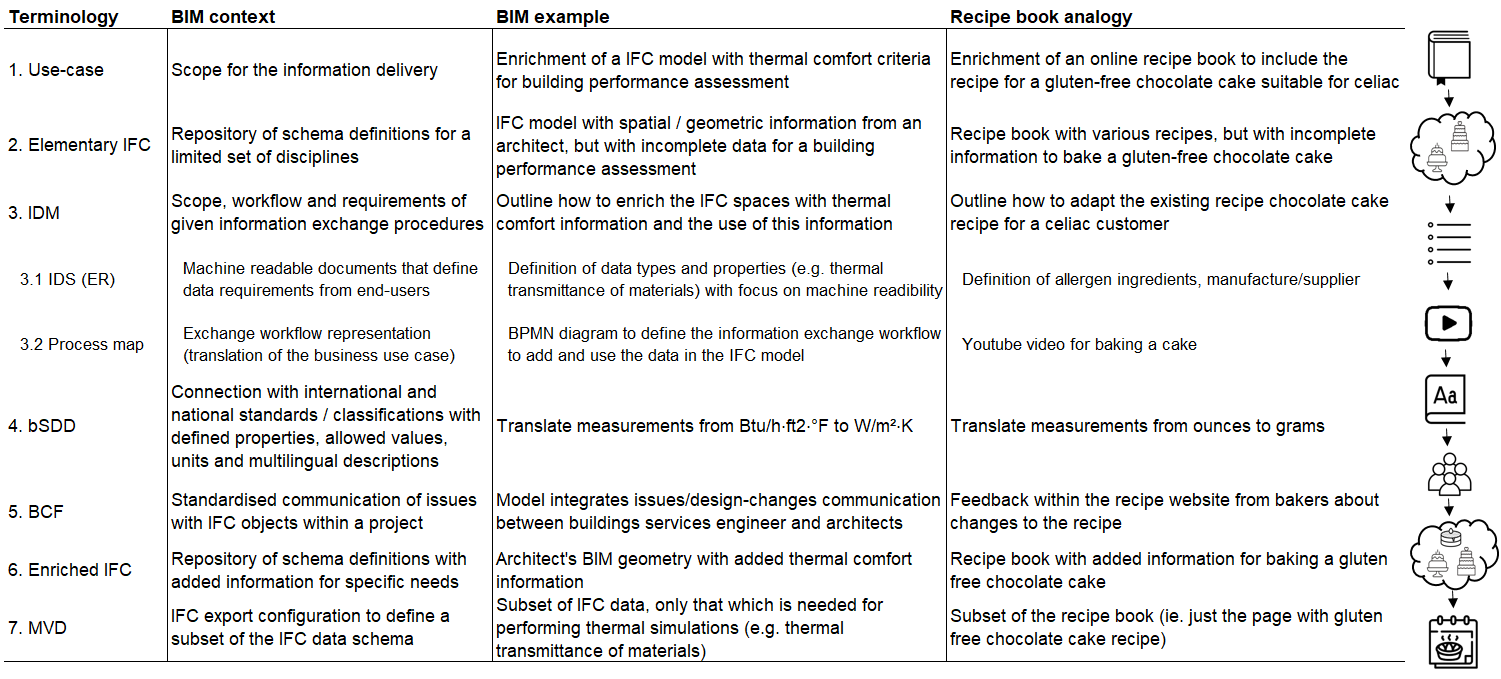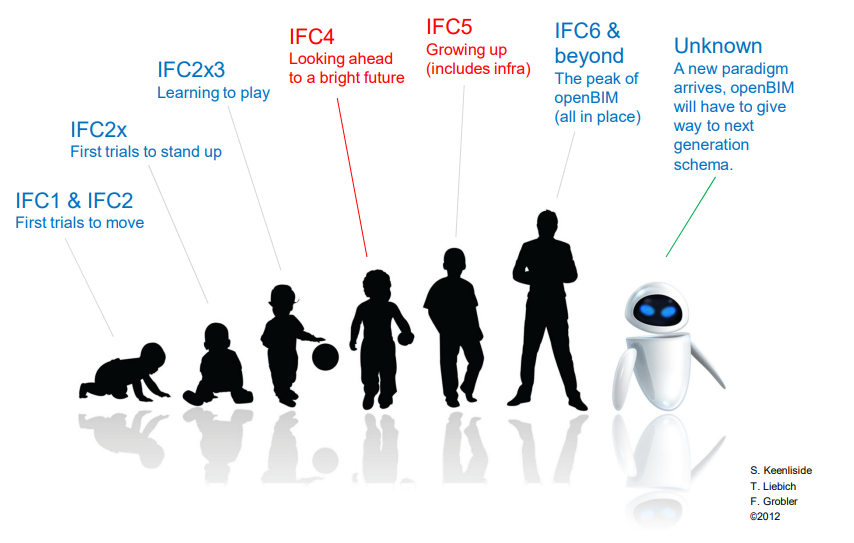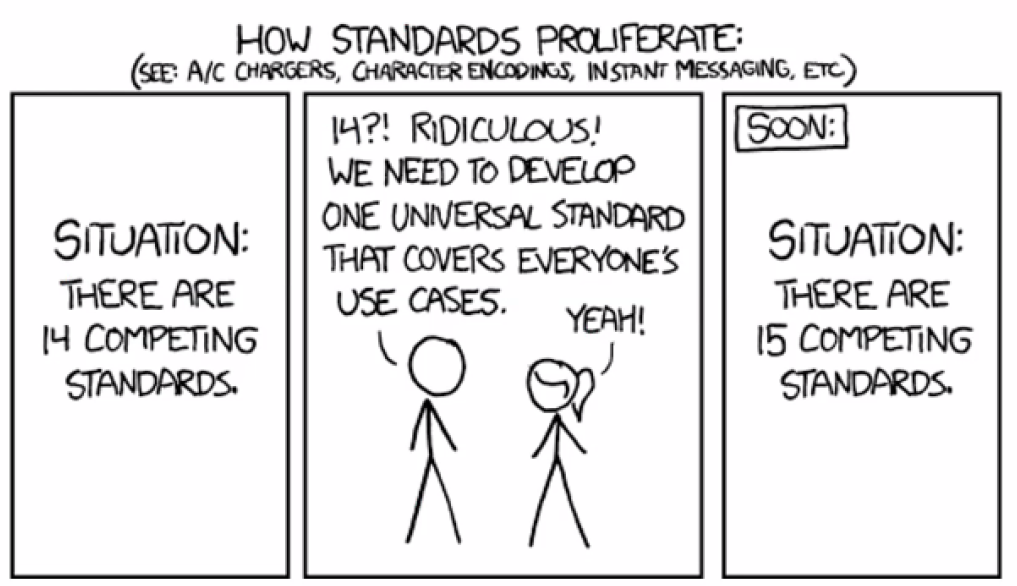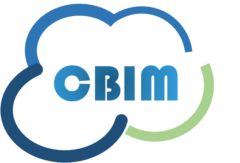



CBIM - European Training Network
Current and upcoming OpenBIM Standards
|
The Architecture, Engineering and Construction (AEC) industry has traditionally been dependent on highly fragmented workflows from various disciplines and life cycle stages [1]. This fragmentary aspect leads to data silos challenges, such as limited collaboration between stakeholders, weakened data integrity, data redundancy and duplication. Emerging OpenBIM standards are assisting the AEC industry in overcoming these challenges by promoting interoperability based on collaborative workflows that allow better data exchange between building information modelling (BIM) applications [1]. The use of OpenBIM standards can result in better data accessibility, usability, management, sustainability and, ultimately, better data quality and integrity [2]. Overview of OpenBIM Standards To understand the concept of OpenBIM, Baldwin (2017) [3] provided a great analogy comparing OpenBIM workflows to PDF workflows, in which the exchange of files in .pdf format does not require the recipients to have the same or compatible application, in order to view the content, as is the case with Microsoft Word or Apple Pages native (proprietary) files. In BIM processes, exchanging a model data in a native format, called nativeBIM, requires the recipient party to have the same or compatible software to view and edit it. On the other hand, if the model is exchanged in an open exchange format, such as IFC, the model data can be freely viewable, usable and modifiable. As a Word document is the basis of PDF (open) and Word (closed) exchange workflows, nativeBIM file formats are the basis of openBIM and closedBIM exchange workflows, the difference is that for closedBIM workflows, openBIM standards are intentionally excluded and the file exchange is based exclusively in a native format (Figure 1). Figure 1: Exchange workflow analogy [3] Although proprietary standards can mitigate data inconsistencies, losses and omissions, within BIM-based exchange workflows, they are highly dependent on specific software vendors and single disciplines. Non-proprietary, or OpenBIM, standards, on the other hand, are vendor-neutral providing an increased level of flexibility, scalability and multidisciplinary interoperability through a common alignment of information and workflow processes. Open standards alignment To date, no single data standard fits all building information requirements. Depending on the granularity of the information and the degree of interoperability to be supported by a business process, different exchange formats are required. ISO 16739-1 (IFC), CityGML, IndoorGML and InfraGML are some examples of open, standardised data schemas used for information exchange. These open formats are prerequisites for open data. They provide common ground for exchanging information while leaving room for competitive advantages. Some overlap between open data standards is necessary in order to cover all information requirements related to an asset. For example, Gilbert et al. (2020) demonstrates the overlap between IFC, CityGML and LandInfra using Figure 2 and Figure 3. The venn diagram in Figure 2 shows that the three data standards have their own structure and features but they all overlap when it comes to the concept of buildings. Similarly, in Figure 3, some classes from the three standards are presented. Although most of the classes represent different concepts, all three data standards have a class that represents the concept 'Building' [4]. Figure 2: Overlap between IFC, CityGML and LandInfra [4]
Information and workflow processes As previously mentioned, the extent and detail of geometry, information and documentation needed within exchange workflows varies with specific purposes, milestones, actors and granularities. Hence, for describing the information to be exchanged, the level of information needed should be identified. For that, the European norm EN 17412-1:2020 establishes a methodology for specifying the level of information needed (LOIN) based on standardised concepts and principles. The use of this standard promotes consistent information deliveries when using BIM. For the management of BIM information across an asset lifecycle, the ISO 19650 series, published by the International Organization for Standardization (ISO) presents concepts and principles for organization and digitization of information about buildings and civil engineering works, including BIM. This standard series is based on the UK’s standards for information management using BIM, PAS 1192-2:2013, PAS 1192-3:2014 and PAS 1192-5:2015 and it also covers the principles and high-level requirements of the UK BIM Framework. According to ISO 19650 series, the definition of information requirements for exchange worklos should specify for what (purpose), when (milestone/event), how (content, form and format) and for whom (recipient party) the data is being created. The different types of information requirements and information models given by ISO 19650-1:2018 are presented in Figure 4. In the figure, “encapsulates” means “provides the input to”, “contributes to” means “provides an input to”, and “specifies” means “determines the content, structure and methodology” [5].
Open BIM Standards from buildingSMART buildingSMART is the worldwide organization driving the transformation of the built asset industry through liaises with international, regional and national standardisation bodies to drive the development of open standards for OpenBIM. buildingSMART develops and maintains industry standards such as IFC, IDS, bSDD, openCDE API, and BCF, and provides agreements regarding data models, processes and terms. IFC- data schema The industry foundation classes (IFC), which is the basis for ISO 16739-1:2018, is the dominant non-proprietary data model that allows data exchange between BIM applications throughout an asset's life cycle. IFC specifies a data schema and an exchange file format structure that is currently based on the technology of the ISO 10303-11 standard for the Exchange of Product data (STEP), its modelling language, EXPRESS, and in the product data representation and exchange standard ISO 10303-21. The latter enables product data described in the EXPRESS language to be transferred from one computer system to another. IFC can also be defined in XML Schema definition language (XSD) allowing building models to be shared in XML format as ifcXML [6]. In addition, IFC has a semantic web based format known as ifcOWL, which shares the same status as the EXPRESS and XSD schemas. IFC provides the foundation to OpenBIM data exchanges as it represents an open, neutral, comprehensive, customizable and extensible data schema. The IFC data schema has been under active development since its first version in 1995. The official version to date is IFC4.0.2.1 or IFC4 ADD2 TC1, while the most recent release, IFC4.3, has been published as a release candidate to accommodate infrastructure works. On each of the successive releases, the scope and features of the IFC data schema have been enhanced to incorporate extensions and removals reflecting the industry demands. See here the release notes for each IFC schema, and also here the differences between IFC4 and IFC2x3 schemas. BuldingSMART keeps a list of software applications that claim to implement IFC, which to date has 341 entries. (An introductory tutorial to the IFC schema Using Unified modeling Language (UML) diagrams can be found here) MVD- a subset of IFC There is no single “all-in-one” IFC implementation, instead, the “Full IFC” is a repository of schema that provides definitions for different domains and allows for information management throughout an asset's entire lifecycle [7]. Therefore, domain-specific exchanges require unique schemas, known as Model View Definition (MVD). MVDs are used to define subsets of the IFC schema according to target information exchange requirements of use specific models, such as structural analysis, coordination or basic facility management (FM) handover view (Figure 5). The coordination and basic FM handover view are formal bSI MVDs which define, respectively, spatial and physical elements for design coordination and design, planning and commissioning of CAFM and CMMS applications. A list of MVDs compiled by buildingSMART along with their use case can be found here. Figure 5: Definition of different IFC model views according to the desired purposes [8] IDM- requested instantiation of IFC subset The specification of model views is supported by Information Delivery Manual (IDM) frameworks, which define guidelines for describing the scope, workflow and requirements of given information exchange procedures. The specification of the scope and information exchange requirements (ER) are driven by use-case definitions, while the representation of the workflow is based on process maps (using the Business Process Modelling Notation (BPMN) and Unified Modeling Language (UML) standards, for instance). A comprehensive IDM should define:
In summary, IDM focuses on the user-centric view of information exchanges between processes, defining data needs according to the level of information need framework established by the EN 17412-1:2020, whereas MVD focuses on the software implementation-centric view to describe the exchanges that can be supported by a given software adhering to an IFC subset. IDS- ER definition The Information Delivery Specification (IDS) is a standard currently under development, which aims to define use-case specific instance level requirements through a machine-readable document. The use of IDS will enable users and software applications to map and validate data exchange against IFC requirements, improving the predictability and reliability of data exchange workflows. This standard will also be able to specify properties and classification, while linked to data dictionary concepts. bSDD- data dictionary The IFC schema contains only internationally agreed information, thus a connection to classification systems, use case specifics or domain specific standards is required (Figure 6). To meet this requirement, the buildingSmart Data Dictionary (bSDD) online services can be used. The primary goal of these services is supporting BIM model enrichment by reusing & extending standards in a very consistent way.
bSDD supports the distribution and publication of standards (international, local & organizational), hosting classifications, properties, allowed values, units and multilingual descriptions. It also links content from inside & outside bSDD databases using URIs, provides a standardised workflow that ensures data quality and enables compliance check procedures. CDE - common data environment Common Data Environment (CDE) is a collaborative environment for collecting, managing and disseminating project documentation (graphical models and non-graphical data) to all stakeholders. ISO 19650 defined the concept behind a CDE and the procedures that software tools must be compliant with to connect team, models, and project data in a single environment. A list of the most popular CDE platforms can be found here. OpenCDE-API is an initiative under development within the buildingSMART international for open, standardised APIs for CDEs to lower threshold data exchange and sharing on BIM-based projects. “OpenCDE-API’s mission is to connect data silos by different software vendors by moving towards an object level data exchange eliminating the current file-based data silos” [10]. BCF - collaboration BIM Collaboration Format (BCF) is a standard used for multilateral communication of BIM design issues (e.g. using an issue management system on the cloud). Through BCF files/messages that include the modification requirement and model references (i.e. name of message, description, IDs of IFC objects, camera view point, issue priority, responsibility assigned), multiple users can seamlessly communicate issues with IFC objects within a project. Such a request can be sent via file-based workflow or web service-based API to the concerned disciplines, which can open/modify the BCF in BIM authoring tools, and answer to the BCF with a modified IFC model. See here an interesting tutorial for multidisciplinary collaboration with BCF by Mathijs Natrop during the last bSI virtual summit. This “role play” recreated a scenario and workflow based on different stages of a building life cycle and a large amount of software tools to demonstrate how productivity can be raised using BCF. Summary of open standards Table 1: buildingSMART abbreviations context, example and analogy bsI - Technical Roadmap The recent bSI technical roadmap [9] has focused on enhancing BIM scalability and adoption by transforming the current standards and solutions towards more generic, semantic and integrated technology bases (Figure 7).
Next generations of IFC are expected to be simpler, more consistent, and predictable. While IFC’s current structure is focused on file-based technologies, next generation IFCs will support web service-based APIs, digital twin applications, and sensor information streams, unlocking the potential of future smart buildings and cities (Figure 8).
While the benefit of openBIM standards is evident in enabling scalable and future-proof multidisciplinary workflows throughout the asset lifecycle, not all BIM processes and information requirements can be captured by a single standard, nor is it possible to create universal standards for many different applications. To address this distributed nature of the AEC industry, the proliferation of countless new standards is not sustainable, what is needed instead is the use and alignment of existing standards (Figure 9).
This blog post was based on a recent lecture given by Thomas Liebich during the Cambridge BIM School held in December 2020. Thomas is the Managing Director at AEC3 and recognized BIM expert who plays an active role in different buildingSMART committees. Other references [1] Sacks, R., Eastman, C. M., Lee, G., and Teicholz, P. (2018). BIM Handbook: A Guide to Building Information Modeling for Owners, Designers, Engineers, Contractors and Facility Managers. John Wiley and Sons, Hoboken, NJ. (Chapters 1-3) [2] buildingSMART International Ltd., openBIM (https://www.buildingsmart.org/about/openbim/). Accessed on 04.06.21. [3] Baldwin, Mark, 2017. What is openBIM? (https://bimconnect.org/en/wiki/what-is-openbim/) [4] Gilbert, Thomas, Hans-Christoph Gruler, Thomas H. Kolbe, Aidan Mercer, Nick Nisbet, Jim Plume, Carsten Rönsdorf, Scott Simmons, and Léon van Berlo. 2020. Built Environment Data Standards and Their Integration: An Analysis of IFC, CityGML and LandInfra. [5] International Organization for Standardization (ISO). 2018. ISO 19650-1:2018 Organization and digitization of information about buildings and civil engineering works, including building information modelling (BIM) — Information management using building information modelling — Part 1: Concepts and principles. [6] Pauwels, P., Zhang, S., and Lee, Y.-C., Semantic web technologies in AEC industry: A literature overview, Autom. Constr., vol. 73, pp. 145–165, (2017), doi: 10.1016/j.autcon.2016.10.003. [7] Liebich, Thomas. IFC Overview presentation, 2014. (https://www.bre.co.uk/filelibrary/events/BRE%20Events/BIM%20Conference%20Season/Delivery%20of%20IFC/2-Thomas-Liebich.pdf) [8] Autodesk. Revit IFC manual: Detailed instructions for handling IFC files. 2018 (https://damassets.autodesk.net/content/dam/autodesk/draftr/2528/180213_IFC_Handbuch.pdf). Accessed on 11.06.21. [9] buildingSMART International Ltd., Technical Roadmap buildingSMART Getting ready for the future, April 2020 (https://buildingsmart-1xbd3ajdayi.netdna-ssl.com/wp-content/uploads/2020/09/20200430_buildingSMART_Technical_Roadmap.pdf). [10] buildingSMART International Ltd., Open CDE APIs - Activity proposal, April 2020 (https://github.com/buildingSMART/OpenCDE-API/blob/master/Documentation/AP-OpenCDEAPIs-20200428-v1_0.pdf). [11] Schoenfeld, Jon. Ontology Alignment Project, Haystack Connect 2021 (https://vimeo.com/547937258). |

Flavia de Andrade Pereira |
 Conor Shaw Data fusion for operational optimization and facility management |
 Eyosias Dawit Guyo Eyosias Dawit GuyoData standards integration |
